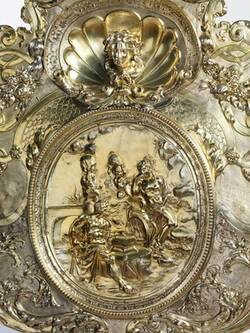Of the best, only the very best – the same motto also applies to the other appointments, incidentally. Take a look around the room and note the large mirrors above the fireplace and on the window piers. We think of them as nothing out of the ordinary – but in the early 18th century, mirrors of this size were the most prized features of the interior decoration, only rivalled by the textiles.
That’s because they were extremely expensive. The means of casting mirror glass of this size had only been invented in the late 1680s in France. It was an elaborate process that was still highly complex technically. The large mirror over the fireplace alone cost 2,700 Reichsthaler. Like the two small mirrors on the window piers, it had been made by the Prussian mirror manufactory. That made it one of the largest ever produced in 18th century Berlin.
At the top of the mirrors on the window piers, the monogram “AR” – Augustus Rex—with a crown above appears in the decoration’s central cartouche. It was another unmistakable hint, intended to remind visitors where they were: in the king’s Audience Chamber!
The suite of silver-gilt furniture served the same purpose. It consisted of the pair of tables, the four guéridons, the two wall sconces with mirrored glass, and finally the spectacular fire screen. In combination, they also formed a strong counterweight to the silver gilt pilasters on the walls while also serving as a perfect complement.
There are very few European collections in which the silver furniture from the period around 1700 has survived the various drives to fund government expenditure and wars by melting down precious metals. In that sense, and of course due to the exceptional quality of the pieces, and the well-preserved gilding, Dresden’s silver furniture is of particular significance. The next room on our tour is the State Bedroom. You'll easily recognise it by its distinctive colour scheme, with accents provided by green velvet hangings.
